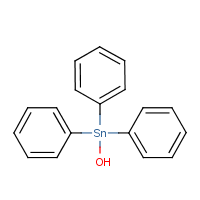Triphenyltin hydroxide
Agent Name
Triphenyltin hydroxide
Alternative Name
Fentin hydroxide
CAS Number
76-87-9
Formula
C18-H16-O-Sn
Major Category
Metals

Synonyms
Brestan H 47.5 WP fungicide; Dowco 186; Du-Ter; Du-Ter Fungicide; Du-Ter Fungicide Wettable Powder; Du-Ter PB-47 Fungicide; Du-Ter W-50; Du-Tur Flowable-30; DuTer extra; ENT 28009; Erithane; Fenolovo; Fentin; Fentin [ISO]; Fentin hydroxide [BSI]; Fentine [ISO-French]; Fintin hydroxid [German]; Fintin hydroxyde [Dutch]; Fintin idrossido [Italian]; Fintine hydroxide [French]; Fintine hydroxyde [French]; Flo Tin 4L; Flo-Tin 4L; Haitin; Haitin WP 20 (fentin hydroxide 20%); Haitin WP 60 (fentin hydroxide 60%); Hydroxyde de triphenyl-etain [French]; Hydroxytriphenylstannane; Hydroxytriphenyltin; Ida, Imc Flo-Tin 4L; Idrossido di stagno trifenile [Italian]; K 19; K 19 (VAN); K19; OMS 1017; Phenostat-H; Stannane, hydroxytriphenyl-; Stannol, triphenyl-; Sunitron H; Super Tin 4L Gardian Flowable Fungicide; Suzu H; TPTH; Tenhide; Tin, hydroxytriphenyl-; TPTH Technical; TPTOH; Trifenyl-tinhydroxyde [Dutch]; Trifenylstanniumhydroxid [Czech]; Triphenyl tin hydroxide; Triphenyl-zinnhydroxid [German]; Triphenylstannanol; Triphenylstannium hydroxide; Triphenyltin oxide; Triphenyltin(IV) hydroxide; Triple Tin 4L; Tubotin; Vancide KS; Vito Spot Fungicide; Wesley Technical Triphenyltin Hydroxide; [ChemIDplus] UN3146
Category
Tin Compounds, Organic
Description
White odorless solid; [HSDB] Off-white powder; [MSDSonline]
Sources/Uses
Used in insecticides, non-systemic fungicides (potatoes, sugar beets, nuts, rice, beans, and vegetables), and antifouling paints; Not currently registered with the EPA for use in the US; [HSDB]
Comments
Animals given a single lethal dose have tremor, drowsiness, and ataxia; In other animal studies, it has effects on the immune and reproductive systems; [Reference #1] A skin, respiratory tract, and severe eye irritant; May cause CNS effects; Can be absorbed through skin; May be toxic to the immune and reproductive systems; [ICSC] Causes redness and pain to skin and eyes; Can be absorbed through skin; [HSDB] A skin and mucous membrane irritant; [CAMEO] A skin irritant; Corrosive to eyes; May cause skin sensitization; [eChemPortal: ERMA] A skin and respiratory tract irritant; May cause serious eye injury; [eChemPortal: ESIS] An irritant; May cause serious eye injury; Can be absorbed through skin; [MSDSonline] See "ORGANOMETALS." See "Tin, organic compounds."
Restricted
Banned for use as a pesticide for plant protection and biocide in the EU; [eChemPortal: ESIS]
Reference Link #1
Biomedical References
Exposure Assessment
Skin Designation (ACGIH)
Yes
TLV (ACGIH)
0.1 mg/m3, as Sn
STEL (ACGIH)
0.2 mg/m3, as Sn
PEL (OSHA)
0.1 mg/m3, as Sn
MAK
0.002 mg/m3, inhalable fraction, as Sn
IDLH (NIOSH)
25 mg/m3, as Sn
Vapor Pressure
3.53E-07 mm Hg
Lethal Concentration
LC50 (rat) = 60.3 mg/m3/4h
Explanatory Notes
The Guide in the Emergency Response Guidebook is for "Organotin compound, solid, n.o.s." Organic tin compounds have a "skin" designation and are classified as "A4" (Not classifiable as human carcinogen); [ACGIH]
Reference Link #2
Adverse Effects
Neurotoxin
Other CNS neurotoxin
Hepatotoxin
Hepatoxic (a) from occupational exposure (secondary effect) or (b) in animal studies or in humans after ingestion
Reproductive Toxin
Yes
ACGIH Carcinogen
Not Classifiable
Diseases, Processes, and Activities Linked to This Agent
Processes
Industrial Processes with risk of exposure: